JAJU880 December 2022
3.3.5 Working Modes Transition
This design has three working modes: normal mode, standby mode, and ship mode. When the pack is charging or discharging, the pack is in normal mode. Sleep mode is when there is no charging nor discharging, the pack is waiting for a charger or load attachment. Shutdown mode is a very low current consumption mode which saves energy and helps to avoid battery over discharge when the pack or cell voltage is low. Figure 3-17 shows different working mode transitions.
 Figure 3-17 Ship Mode to Normal Mode
Figure 3-17 Ship Mode to Normal ModeWhen TIDA-010247 is in ship mode and both BQ76942 devices are in shutdown mode. The bottom BQ76942 detects charger attached on PACK side and wakes up to normal mode, enabling REG1 or REG2 to power on the MCU.